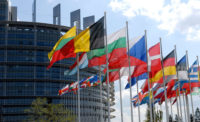A leading European scientist says it’s “quite urgent to understand the exact mechanisms of nanotoxicity and make a classification depending on the mechanism.”
That warning from Dr. Vladimir Baulin of the University Rovira i Virgili in Tarragona, Spain comes with a reminder that radioactivity or x-rays “entered our lives the same way,” but that it took some time before researchers understood how they affected living organisms.
Baulin has co-authored an article published in last November in Science Advances that shows for the first time that nanoparticles can cross biological - or lipid – membranes. The study resulted from the EU-funded SNAL project.
‘This is the first observation to show directly how tiny gold nanoparticles can cross a lipid bilayer (main part of a biological membrane),” said Baulin in an interview with Horizon-magazine.eu, the periodical of the DG Research of the European Commission.
“The lipid membrane is the ultimate barrier protecting cells from the outside environment and if the nanoparticles can cross this barrier they may go into cells.”
More recently, researchers from the French National Institute for Agricultural Research (INRA) have also shown that nanoparticles of titanium dioxide contained in the additive E171 can cross the intestinal barrier in animals. Immune system disorders linked to the absorption of the nanoscale fraction of E171 particles were observed. The researchers also showed that chronic oral exposure to the additive spontaneously induced preneoplastic lesions in the colon, a non-malignant stage of carcinogenesis, in 40% of exposed animals. Their findings were published in the 20 January 2017 issue of Scientific Reports.
E171 is commonly used in foodstuffs, especially confectionery, to whiten or give opacity to products. Composed of micro- and nanoparticles, E171 is nevertheless not labelled a “nanomaterial”, since it does not contain more than 50% of nanoparticles.
Nanomaterials have invaded most of products used in our daily life. They are found everywhere: from cosmetics (creams, toothpastes, and shampoo), food components, clothes, buildings cement, paints, car tires, oil, electronic products, etc.
Further reading:
Source: ETUI.org

